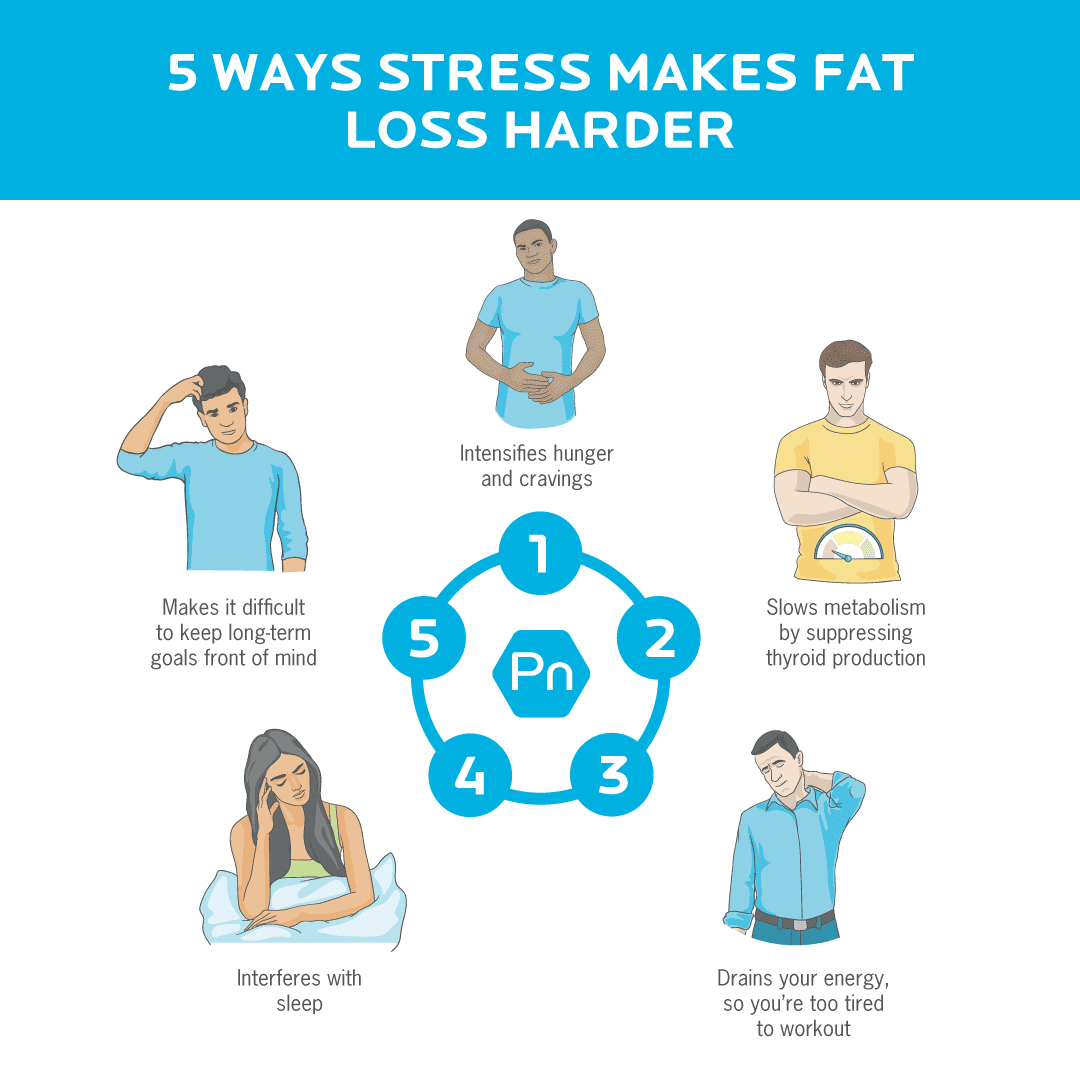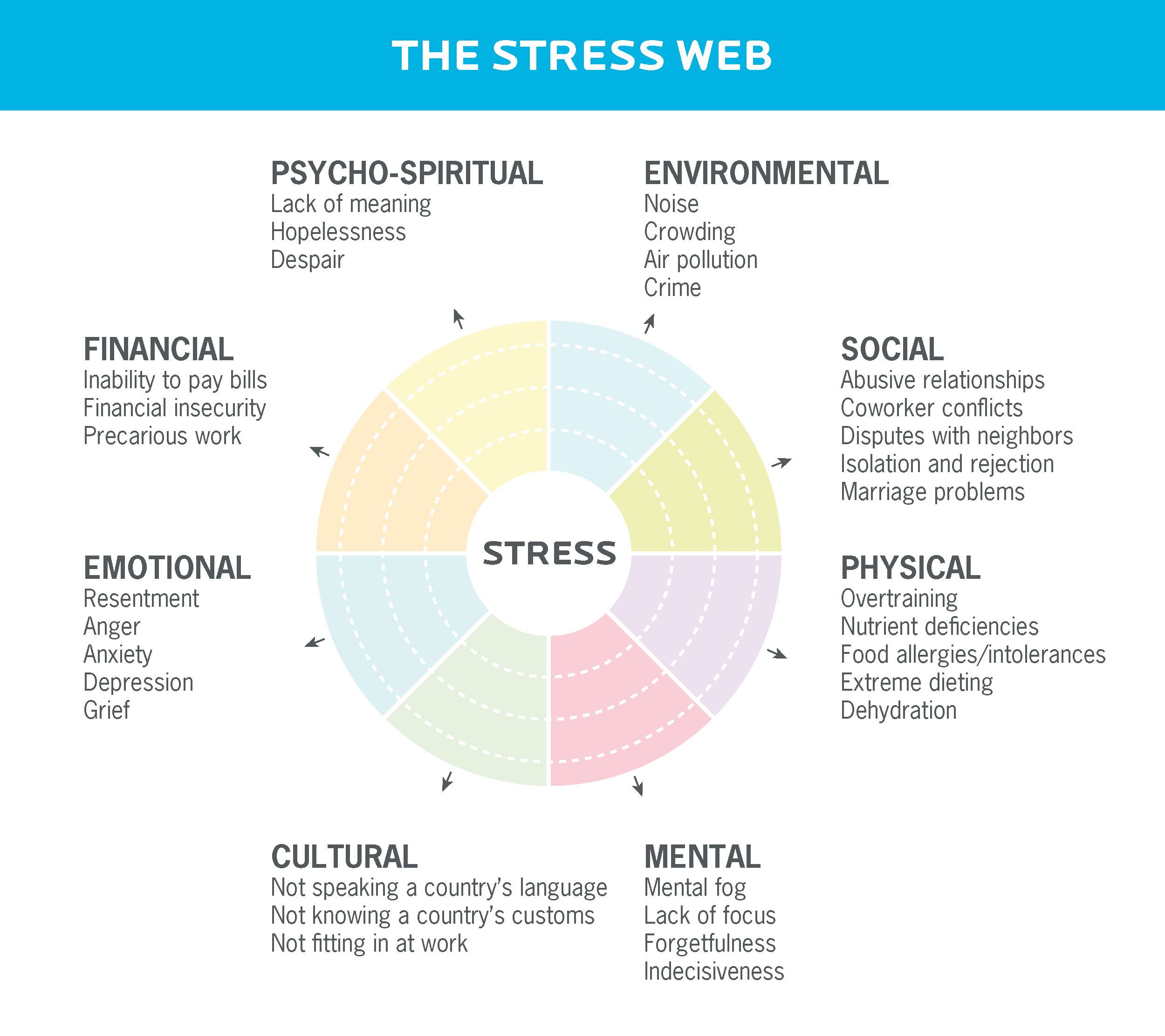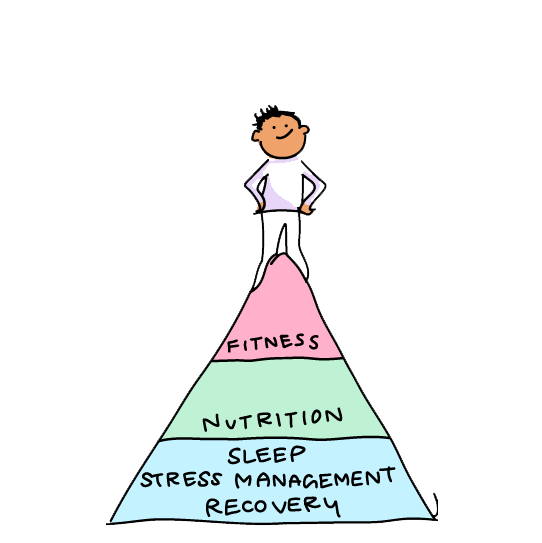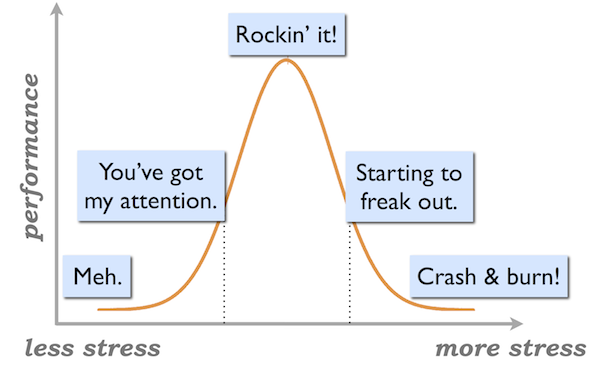When someone struggles to lose fat, it can tell you a lot.
It’s like a dashboard indicator that alerts you to problems.
Except, unlike your car’s dashboard, this warning sign doesn’t come with an owner’s manual that helps you pinpoint the precise problem.
The issue, of course, could be lots of things.
Maybe someone is unintentionally eating more than they’re tracking. They’re not realizing, for example, the true size of their portions.
Or, for people who’ve been dieting for a long time, perhaps their metabolism has adapted and a reverse diet could be in order.
But what if the problem doesn’t start with food?
Let’s say it stems not from what someone’s eating, but rather from how they’re coping with any number of stressors, from anxiety to anger to unhappiness to lack of sleep.
For example:
- They’re pounding soda all day… because of a high-pressure job.
- They’re skipping exercise… because of the challenges of new parenthood.
- They’re binging at night… because of some deep-seated resentment, smoldering just beneath the surface.
There’s almost no way to fix the secondary problem until you’ve addressed the root issue. In fact, lifestyle stressors not only make fat loss harder, they can make it darn near impossible for some.
So much so, they can be the X-factor for fat loss: the one variable that matters most for success.
Many nutrition coaches understand this, of course.
But our clients?
They often see us as people who know a lot about carbs and vitamins and portion sizes—and not as advisors capable of helping them navigate their deeper, more personal problems.
So how do you help clients go there? Without accidentally offending them? Or having them say something like, “You’re a nutrition coach, not a shrink…”?
And how do you translate a conversation about stress into action steps that can kick start fat loss?
Just keep reading. In this article, you’ll find:
- Coaching scripts for helping clients recognize which stressors are making it harder for them to lose fat
- 30+ ideas for how clients can lower stress levels, calm anxiety, and, ultimately, make better nutrition and lifestyle choices
- A simple coloring exercise that empowers clients to come up with their own stress management solutions
All to help frazzled, frustrated clients slow down their lifestyle—and speed up their progress.
(If you want to see the authors discuss this article in even more detail, check out the video below. If not, simply scroll over the video player or click here to jump to the next section.)
PN coach roundtable: Robin Beier talks stress and fat loss with Jason Bonn and Alisa Bowman.
The challenge of coaching stressed out people
Most people know that too much stress is bad for them.
But their stressors often live so far upstream that they don’t connect them with their stalled fat loss.
They might blame it all on a lack of willpower, assuming they just need to try harder, stop being so lazy, eat even less food, or exercise even more.
And as their coach, it’s easy to become trapped in the “this person just needs a little accountability” mindset.
But as you probably know, serving as their nutritional drill sergeant doesn’t generally work—at least not long term.
So, what can you do?
Start by considering whether your client has any of these signs of stress.
(For more helpful ways to better cope with life’s stressors, improve your sleep and recovery, and become your best possible self, sign up for our FREE newsletter, The Live Better Project.)
Sign #1: They look, sound, and act frazzled.
Some people make it easy. During an intake they might just come out and say, “You know, stress is a big problem for me.”
Or maybe they say, “I’ve literally tried everything. I’m starting to think it might be stress related. What do you think?”
Other clients, however, are more subtle.
They might not communicate their stress with actual words, but rather with their tone of voice, their pinched facial expression, or the flurried way they send texts at midnight. And at 2 a.m. And 3 a.m.
They also might reveal it in their writing style: lots of exclamation points, a generous use of all caps, or a proclivity for angry emojis. For them, it’s almost as if they just don’t have time to bother with punctuation or capitalization. They’re that busy.
Sign #2: Only someone with superpowers could do their life.
Your client might, in passing, mention that they have a full-time job as well as a side hustle. A little later, the same person reveals they’re raising three beautiful children—all under age 5.
And one of them has a chronic health condition.
Oh, and their in-laws just moved in.
Such people might wear stress like a badge of honor. But you’re left wondering: How are they still walking around?
Sign #3: They’re perfectionists at nutrition, health, and fitness.
We often think of “bad” things when we think of stress. Financial problems. Concern for the welfare of friends and family. Anxiety over an uncertain future.
But many things we file into the “good for us” category can become “bad for us” if left unchecked. Things like:
- Pushing too hard, too often at the gym—without enough rest days. This can break down your body, leading to injuries, fatigue, lowered immunity, drops in performance, a slower metabolism and, ultimately, fat gain.1
- Extreme, prolonged dieting. Strict, low-calorie diets tend to elevate levels of the stress hormone cortisol.2
- A preoccupation with “clean eating.” People who are obsessed with eating healthy foods (a condition known as “orthorexia”) tend to have greater body mass indexes (BMIs) and waist circumferences than people who aren’t as obsessed, found one study.3
Any of those stressors can impede fat loss, especially if they’re bundled with other problems such as insomnia, nutrient deficiencies, and food intolerances.

If your client can’t lose fat, get curious.
Even when clients know they’re stressed out, they rarely think: “You know what I really need? More relaxation. Better coping strategies. A therapist.”
Which puts you in a delicate position as their coach, especially if you’re working with a new client.
For now, ignore any instinct to bring your client’s attention to the stress—because that’s not going to work.
Instead, focus on building trust and awareness.
How do you do that? Keep reading.
Give trust some time.
The average person generally doesn’t reveal details about their abusive childhood, toxic relationship, or financial worries to just anyone. They often only open up with people they’ve known for a while.
That takes time.
But you can speed things up by leaning into the skills and techniques that already make you a great coach. In other words:
- Put your client first.
- Ask curious questions.
- Listen deeply.
- Restate what you’ve heard.
- Empathize.
- Work on nutrition and fitness goals your client feels ready, willing, and able to do.
Even if you have an inkling as to what’s going on with your client, do your best to show up curious. Adopt a mindset of humility. You might be right that your client really could use a bit of stress management. But you also might be wrong. So work together to sort it all out.
(You’ll find more specifics on exactly how to do this—with sample conversations—a little later in this article).
Use nutrition practices that create awareness.
Try to see this as a game where the goal is to help your client become aware of the problem, without giving your personal thoughts and opinions on the matter.
Maybe you help your client establish any number of nutrition practices that offer the side benefit of building more awareness:
- Eating slowly to tune into eating behaviors and appetite signals
- The notice and name technique to generate awareness into thoughts, feelings, sensations, and emotions that can lead to stress eating
- Behavior awareness to help them see how stress, busyness, thoughts, and surrounding circumstances connect to what and how much they eat
- Diet experiments to test whether their life circumstances and surrounding environment affect their eating, energy level, and more
Those tasks fit right into your “nutrition coach” toolkit. To your client, it totally makes sense that you might suggest they keep a food journal, for example. And yet this practice can help your client see they tend to dive into a gallon of ice cream only after they’ve had a horrible day at work.
How do you know if you’ve built enough trust to “go there”?
In truth: There’s no definitive test that will allow you to know, for sure, how your client will respond when you bring up their big upstream problem.
But you’re probably in a good space if your client is no longer showing signs of resistance. In other words, during your sessions together, your client continually nods, saying things like, “Yes! Yes! Yes! That’s exactly how it is for me!” And when you go over action steps together, your client consistently puts them right into practice.
If all of that’s happening on a regular basis: You’re ready to try the 3-step process below.
If that’s not happening: Stay with nutrition-centered practices a bit longer. Maybe instead of addressing emotional stress directly, you do it indirectly by helping your client deal with physical stressors such as nutrient deficiencies, food intolerances, or over-training.
Also consider what you might be doing (or not doing) to trigger any resistance. What can you do to help your client feel seen and heard? Are there ways to empathize more with your client’s situation? Could you spend more time listening and restating and less time lecturing?
Step 1: State what you’re noticing.
Any heavy-handed attempt to diagnose a client’s problem and prescribe a solution? It’ll likely backfire.
But you may already know that.
Instead, think of yourself as a mirror that reflects what you’ve noticed. Ask your client for thoughts. Then pause and see if your client can connect the dots.
For example, you might say:
- “Based on your food logs, it looks like you hit the freezer around 7 pm every single night, like clockwork. What do you make of that?”
- “Lately, I’ve noticed that you’ve been taking on so much: side gig, baby-duty every night, your in-laws living with you. Wow, that sounds like a heavy load.”
- “So I hear you saying that you’re training for a marathon, gunning for a promotion at work, and experimenting with intermittent fasting. That’s a lot to tackle all at once. How does this affect you—if at all?”
For some clients, this may be all you need. They may take it and run with it, telling you, “Yeah, I guess my load is kind of heavy.” If you get that answer, move onto step 2.
Other clients might deflect, saying something like, “Nah, it’s really not that bad. I can handle it.”
In this case, back off and redirect your energy toward something else. Maybe you pivot to a conversation about starting a journaling habit, for example.
No matter what you eventually settle on, don’t worry too much. Just by broaching the conversation, you planted a seed—and that’s enough.
Questions are now buzzing in the back of your client’s mind. Eventually the seed will take root.
Step 2: Explore the issue more deeply.
Now that your client has admitted that stress is a problem generally, you’ll want to ask a few questions to help your client make the connection between stress and fat loss.
- Use open-ended questions that help your client investigate possibilities.
- Listen to and affirm whatever your client has to say.
- Ask for permission to fill in any holes in your client’s understanding.
- Include your client in the solution.
The conversation might go like this:
| Coach: Crazy question: You mentioned how stressed you are. Are there any ways it might be affecting your weight or your eating? What are you noticing? |
| Client: I don’t know. Usually? I eat out more when I’m stressed because I just don’t have time to cook. |
| Coach: That’s great that you’ve noticed that. You’re spot on. Funny enough, there are lots of other ways that stress affects body weight too. Are you okay if I share those with you? |
| Client: Sure. |
| Coach: Well, you already mentioned that it can lead you to eat differently. But lots of people don’t know that stress can also drain your muscles of energy, leaving you feeling tired and achy. And it can also slow metabolism and interfere with sleep. What do you make of all of that? Does any of that seem like it might apply to your situation? |
| Client: Yeah, yeah. I think you’re onto something. That might be it. |
| Coach: How do you want to approach this? Is this something that you want to address now? Or do you want to set it aside for a bit and see if we can do other things first? |
Now, let’s say the conversation doesn’t quite go as beautifully as the example above. Suppose you bring up stress and your client is like, “Um, nope. That’s not me.”
That’s alright. Just bookmark it for later and switch to another practice that your client is willing to embrace.
On the other hand, if your client does see the connection? You’re both ready to find solutions, which brings us to step 3.
Step 3: Address the stress.
This step is a lot like the last semester of senior year. Once you’ve gotten this far, the hard work is nearly over. You’re ready to brainstorm stress-soothing strategies as well as ways to reduce your client’s overall stress load.
Brainstorm stress-soothing strategies
To identify calming activities your client can try, use the same process listed under step 2 above: Ask an open-ended question, listen to and affirm your client, ask for permission to fill in any gaps, and include your client in the solution. It might go like this:
| Coach: “What are some practices you think could help with stress management?” |
| Client: Um, I don’t know, maybe meditation… walking in nature… taking a hot bath…? |
| Coach: “Yup. Great job. Those are some of the more popular ones. People have been doing those for a long time with success. What experiences do you have with these?” |
| Client: “Not many. I’ve just heard that some people do those sorts of things. I don’t know if they’re right… for me.” |
| Coach: “I get that. Totally makes sense. Maybe some other options might be a better fit for you. I have some more ideas. Okay if I share them? |
| Client: Nods. |
| Coach: “Some people like to write in a journal, snuggle with a loved one after a long day, or talk to a friend on a regular basis. And some of my clients have found it super helpful to talk to a licensed counselor. Do any of those stand out to you that might be worth trying? What do you think would be the easiest?” |
If your client wants to see a therapist, offer to help find someone, especially if you don’t have a counseling background.
You could say, “I certainly don’t do that, but I can help you search for the right person while we continue to work on these other things. We can work together to find someone who fits well and gives you the support you need.”
(For more stress-soothing ideas, check out “33 ways to calm your mind and body” below.)
33 ways to calm your mind and body
By no means is this list exhaustive. Merely think of it as a jumping-off point for brainstorming. It’s more important to collaboratively explore what a client feels works for them and much less important to serve as a human encyclopedia of stress-relievers.
| Quick & free | >10-minutes with or without a cost | >30 minutes with a paid expert |
|---|---|---|
| Breathe deeply. | Take a nap, with or without a weighted blanket. | Sign up for a massage. |
| Slowly sip herbal tea. | Watch a funny movie. | Try acupuncture. |
| Color or draw a picture. | Organize a closet or drawer. | See a therapist or counselor. |
| Call a friend. | Exercise. | Take a meditation course. |
| Spoon with a person or pet. | Spend time in nature. | Get tested for food allergies, intolerances, and/or deficiencies. |
| Walk barefoot in the grass. | Volunteer. | See a sleep specialist. |
| Sit outdoors in the sun. | Go to an art museum and sit quietly in front of a masterpiece. | Take music lessons. |
| Mindfully wash dishes, focusing on the smell of the soap, sound of the water, and feel of the dishes. | Read the comics. | Take a tai chi, qigong, or yin, gentle, or restorative yoga class, (online or in person). |
| Knit or crochet. | Try guided imagery, yoga nidra, or another “relaxation” visualization. | Learn self-hypnosis. |
| Write in a gratitude journal. | Buy and use an aromatherapy diffuser with essential oils designed for relaxation (such as one that includes lavender). | Investigate flotation-REST (reduced environmental stimulation therapy). |
| Dance while listening to your favorite music. | Sign up for and use a relaxation app. | Try reiki. |
Reduce the stress load
If your client has a lot on their plate, you’ll want to explore ways to reduce the load to a more manageable level.
Maybe you say, “It seems like you’re really pushing yourself. I’m not sure how you do it. I’m wondering how you feel about dialing down your effort.”
Assuming you get the go-ahead, use the stress web (below) for ideas.

1. Ask your client to color in the areas with the most stress. (To download and share our stress web, click here.)
2. Take a look at the colored-in areas, asking questions like, “What’s adding to your stress level in that area?”
3. Use the “little bit better” mindset to help your client come up with small shifts toward life balance. That is, what tiny action might help?
The stress web can be seriously eye-opening for clients. Simply doing this exercise can give your client a visual that creates real awareness and leads to productive brainstorming.
No, your client can’t change the fact that they have a newborn baby or puppy. But maybe they’re willing to stop watching the crime dramas that heighten their stress and instead tune into something more relaxing.
Or maybe they cut back on—but not eliminate—social media if that’s one of their stressors.
Or rather than cardio combat everyday at the gym, your client says they’re willing to try a gentle yoga class.
It’s about the journey—not the destination.
That text above^? It’s a cliché.
But people say it for a reason.
As a coach, you may feel super tempted to fixate on the one perfect destination: that mythical set of techniques that’ll transform your client into a calm yogi who never stress eats and, consequently, easily loses fat.
In reality? There’s no one right destination because the best techniques and solutions will vary from client to client. Some work great for some people—and miserably for others.
The magic isn’t created by the specific practice.
Rather it comes from the conversation that builds your clients’ awareness, self-insight, and inner resources.
Be curious. Ask questions. Listen deeply. Care.
Do all of that and your clients will naturally gravitate toward the stress reduction solutions that work like magic—for them.
References
Click here to view the information sources referenced in this article.
If you’re a health and fitness pro…
When your clients are stressed and exhausted, everything else becomes a struggle: going to the gym, choosing healthy foods, and managing cravings.
But with the right tools, you can help your clients overcome obstacles like chronic stress and poor sleep—leading them toward the lasting health transformations they’ve always wanted.
PN’s Level 1 Sleep, Stress Management, and Recovery (SSR) Coaching Certification will give you these tools. And it’ll give you confidence and credibility as a specialized coach who can solve the biggest problems blocking any clients’ progress. (You can join the SSR Early Access List for our biggest discount + exclusive perks.)



Share